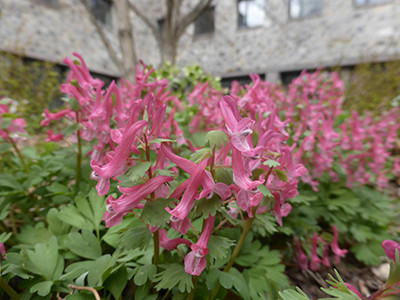
Plants of the Week: April 17
 Who hasn’t ogled and longed for floriferous stands of Meconopis betonicifolia, Cardiocrinum giganteum, or lupins in their home garden? I know I have! Other ogle-worthy plants are the myriad of blue-flowering corydalis cultivars. Alas those blue beauties don’t fare well in our climate. One variety of corydalis that has done remarkably well is Corydalis solida ‘Beth Evans’. Small, shriveled tubers available for planting in the fall give rise to ferny, Dicentra-like foliage and masses of tubular pink flowers resembling tiny snapdragons. Corydalis benefit from consistent moisture and some shade. Don’t be alarmed when plants go summer-dormant. Like most small bulbs, plant in mass for best effect. Corydalis ‘Beth Evans’ can be seen in the Isabel Cosby Courtyard Garden. Photo credit: J. Coceano
Who hasn’t ogled and longed for floriferous stands of Meconopis betonicifolia, Cardiocrinum giganteum, or lupins in their home garden? I know I have! Other ogle-worthy plants are the myriad of blue-flowering corydalis cultivars. Alas those blue beauties don’t fare well in our climate. One variety of corydalis that has done remarkably well is Corydalis solida ‘Beth Evans’. Small, shriveled tubers available for planting in the fall give rise to ferny, Dicentra-like foliage and masses of tubular pink flowers resembling tiny snapdragons. Corydalis benefit from consistent moisture and some shade. Don’t be alarmed when plants go summer-dormant. Like most small bulbs, plant in mass for best effect. Corydalis ‘Beth Evans’ can be seen in the Isabel Cosby Courtyard Garden. Photo credit: J. Coceano
 Aesculus hippocastanum, commonly called horsechestnut, is native to the Balkan Peninsula. The genus is perhaps best known for its flowers and fruit. The Missouri Botanical Garden has this to say about the tree: “Showy white flowers with red or yellow markings appear in upright terminal panicles in mid-spring…fruit is a globular dehiscent capsule consisting of 1-2 horsechestnut(s) encased by a leathery light brown husk covered with sharp spines. Fruit on the tree is interesting but not particularly ornamental. When ripe, each horsechestnut turns a handsome shiny dark mahogany brown with a round light tan scar. Chestnuts and horsechestnuts are in totally different families. Chestnuts (Castanea) are in the beech family (Fagaceae) and produce edible nuts. Horsechestnuts and buckeyes (Aesculus) are in the soapberry family (Sapindaceae) and produce poisonous nuts. Horsechestnut is closely related to Ohio buckeye, being most easily distinguished from the latter by having spiny sharp fruits and sticky buds.” Aesculus hippocastanum is planted between Sproul Observatory and Sharples Dining Hall. Photo credit: J. Coceano
Aesculus hippocastanum, commonly called horsechestnut, is native to the Balkan Peninsula. The genus is perhaps best known for its flowers and fruit. The Missouri Botanical Garden has this to say about the tree: “Showy white flowers with red or yellow markings appear in upright terminal panicles in mid-spring…fruit is a globular dehiscent capsule consisting of 1-2 horsechestnut(s) encased by a leathery light brown husk covered with sharp spines. Fruit on the tree is interesting but not particularly ornamental. When ripe, each horsechestnut turns a handsome shiny dark mahogany brown with a round light tan scar. Chestnuts and horsechestnuts are in totally different families. Chestnuts (Castanea) are in the beech family (Fagaceae) and produce edible nuts. Horsechestnuts and buckeyes (Aesculus) are in the soapberry family (Sapindaceae) and produce poisonous nuts. Horsechestnut is closely related to Ohio buckeye, being most easily distinguished from the latter by having spiny sharp fruits and sticky buds.” Aesculus hippocastanum is planted between Sproul Observatory and Sharples Dining Hall. Photo credit: J. Coceano
 Narcissus ‘Ceylon’ sports an upward-facing 4” buttercup-yellow perianth around an orange-scarlet, funnel-shaped cup. ‘Ceylon’ produces one flower per stem. The variety is great for forcing and makes a great cut flower. A group can be seen in the island bed in front of the Lang Music Building. The neighboring planting of Juniperus virginiana ‘Grey Owl’ seems to intensify the daffodil’s colors and makes for a great backdrop. Photo credit: J. Coceano
Narcissus ‘Ceylon’ sports an upward-facing 4” buttercup-yellow perianth around an orange-scarlet, funnel-shaped cup. ‘Ceylon’ produces one flower per stem. The variety is great for forcing and makes a great cut flower. A group can be seen in the island bed in front of the Lang Music Building. The neighboring planting of Juniperus virginiana ‘Grey Owl’ seems to intensify the daffodil’s colors and makes for a great backdrop. Photo credit: J. Coceano





No Comments